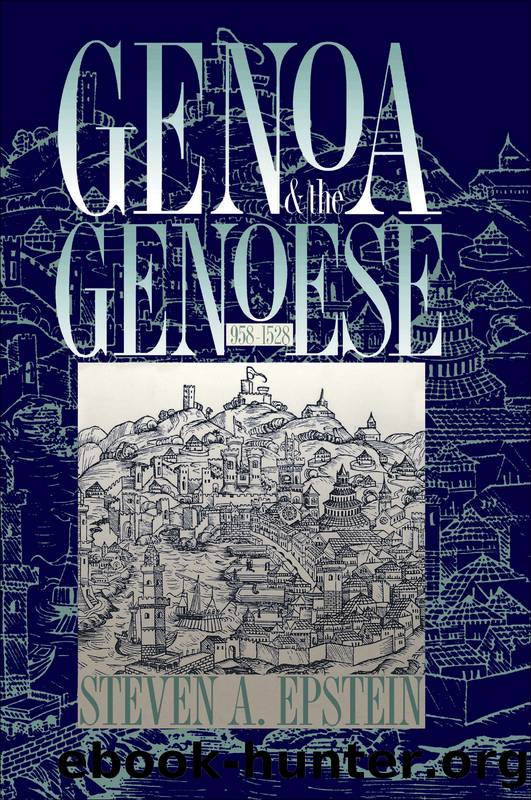Genoa and the Genoese, 958-1528 by Steven A. Epstein & Steven Epstein

Author:Steven A. Epstein & Steven Epstein [Epstein, Steven A. & Epstein, Steven]
Language: eng
Format: epub
Tags: history, Europe, Italy
ISBN: 9780807849927
Google: qM_cJJ5352YC
Publisher: Univ of North Carolina Press
Published: 1996-11-15T00:11:45.850523+00:00
SIMONE BOCCANEGRA AND CHIOS, 1331â1347
Robert of Anjou, king of Naples, ruled Genoa through his rector and a council of eight nobles and eight popolo. In 1335 the new rector, Burgaro de Tolentino, became unpopular with the Ghibellines because they felt that he favored the Guelfs. In February a series of incidents prompted both parties to arm.49 On 27 February the Ghibellines attacked and with the help of the formerly Guelf Salvatico family pushed into Guelf areas. The Fieschi retreated out of town and headed for Piacenza, and by the next day, without any more bloodshed, pillaging, or fires, Robertâs people were allowed to leave. On 9 March, at a parlamento significantly summoned by the nobles, Raffaele Doria and Galeazzo Spinola da Luccoli were elected captains of the people for two years. A new podestà was chosen and the captains ruled the old way, through a council of anziani and the people protected by their abate. Stella maintains that many Guelfs, presumably weary of strife, swore loyalty to the captains, and many nobles simply became Ghibellines. The strongly Guelf Giovanni Villani writes that the revolt ruined Genoaâs good state and diminished its power and trade.50 Once Robert of Naples was out, the Guelf party in Genoa collapsed. Moneglia and Portovenere, held by Guelfs, submitted to Genoese rule. Robert occupied Ventimiglia in the western Riviera, and the Guelfs rallied at Monaco, from where their galleys resumed piracy against the Genoese.51
The captainsâ main policy was to make peace with Aragon, and after a truce was proclaimed in early 1336, both parties came to terms in September.52 This treaty ended the conflict but accomplished nothing for the Genoese in Sardinia. At least peaceful commerce with the east resumed during the truce; significantly, however, the ten galleys sent to trade in Greece and Syria required another ten galleys to protect them.53 Having secured external peace, the captains on 25 March 1337 obtained three more years of rule, this time without a podestà , and they got the right to name the abate.
As Stellaâs account of what he calls an ardua mutatio, a hard changeâthe revolution of 1339âis the only surviving version, we must look carefully at his explanation of what happened.54 Trouble started in the Ghibelline galleys that Genoa had sent to Flanders the previous year. The mariners were in dispute over their wages, and they sent a delegation headed by Pietro Capurro to the king of France. Pietro and fifteen others ended up in prison. Other seamen returned to Genoa and spread news of this by shouting âlong live Capurroâ and presumably describing in some detail their complaints against the shipowners. The men of Savona organized the mariners according to their valleysâVoltri, Bisagno, Polceveraâimplying that many of them came from the small towns and villages of Liguria. John McNeill has observed that the mountains exported people into military service and brigandage; here, the tough men of the valleys took to the sea, possibly to escape the misery of overpopulation.55 It was announced, by whom it is not clear, that Capurro and the others had been put to death, but many refused to believe this.
Download
This site does not store any files on its server. We only index and link to content provided by other sites. Please contact the content providers to delete copyright contents if any and email us, we'll remove relevant links or contents immediately.
| Africa | Americas |
| Arctic & Antarctica | Asia |
| Australia & Oceania | Europe |
| Middle East | Russia |
| United States | World |
| Ancient Civilizations | Military |
| Historical Study & Educational Resources |
Machine Learning at Scale with H2O by Gregory Keys | David Whiting(3660)
Never by Ken Follett(3549)
Fairy Tale by Stephen King(2971)
The Man Who Died Twice by Richard Osman(2823)
Oathbringer (The Stormlight Archive, Book 3) by Brandon Sanderson(2657)
Will by Will Smith(2593)
Rationality by Steven Pinker(2159)
The Dark Hours by Michael Connelly(2092)
The Dawn of Everything: A New History of Humanity by David Graeber & David Wengrow(2023)
Friends, Lovers, and the Big Terrible Thing by Matthew Perry(2018)
Can't Hurt Me: Master Your Mind and Defy the Odds - Clean Edition by David Goggins(2012)
Principles for Dealing With the Changing World Order: Why Nations Succeed and Fail by Ray Dalio(1903)
HBR's 10 Must Reads 2022 by Harvard Business Review(1703)
A Short History of War by Jeremy Black(1679)
Go Tell the Bees That I Am Gone by Diana Gabaldon(1602)
515945210 by Unknown(1525)
443319537 by Unknown(1400)
Kingdom of Ash by Maas Sarah J(1396)
A Game of Thrones (The Illustrated Edition) by George R. R. Martin(1377)
